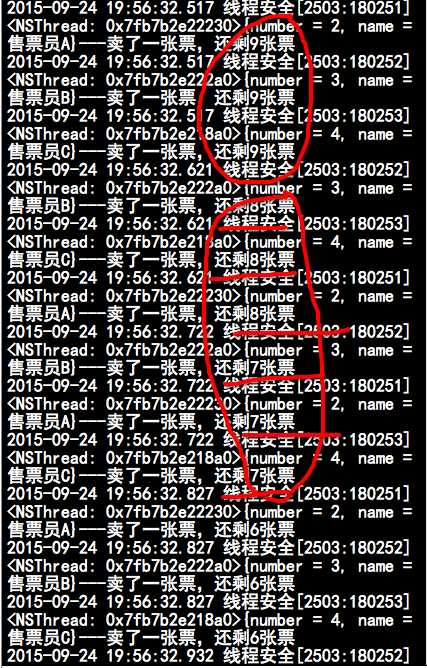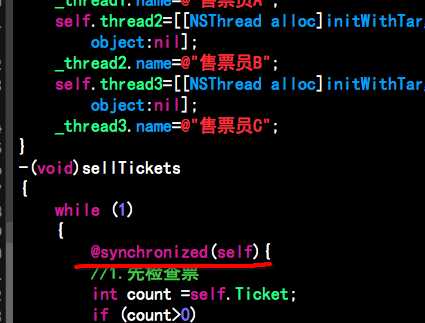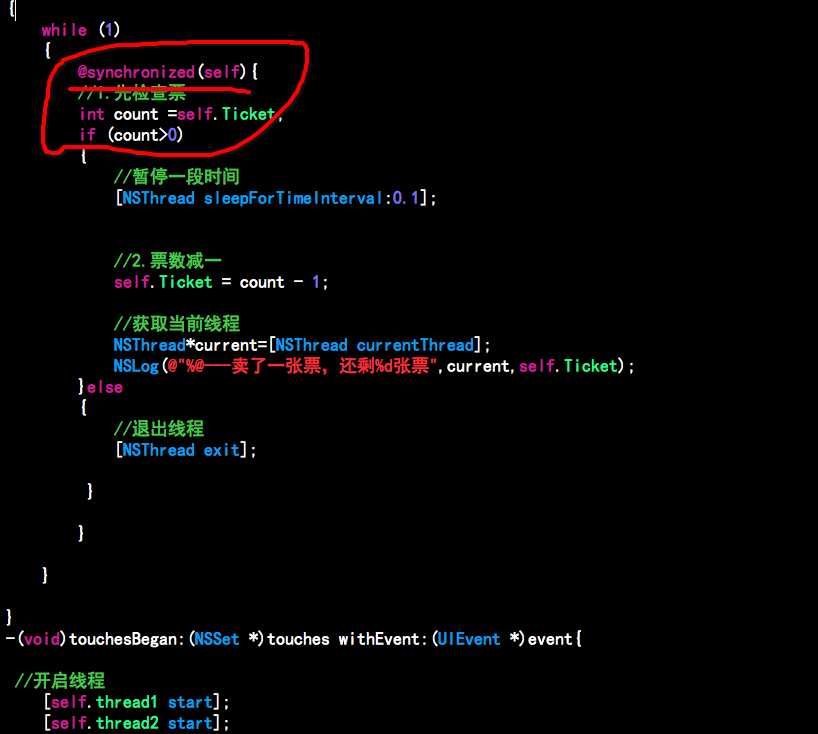标签:
一、资源共享
我们知道一块资源可能会被多个线程共享,也就是多个线程可能会访问同一块资源,不如多个线程访问同一个对象,同一个变量、同一个文件。当多个线程访问同一块资源时,很容易引发数据错乱和数据安全问题。
例如:我们工厂要生产零件,A生产线和B生产线每个线有1000个零件要生产,但是他们用的是同一个零件箱,那零件箱只能放1000个零件,当他们生产完之后还剩很多零件堆着,这时他们很容易产生矛盾。

还有就是一个经典的例子:卖票:

问题代码:
#import "ViewController.h"
@interface ViewController ()
//剩余的线程
@property(nonatomic,assign)int Ticket;
@property(nonatomic,strong)NSThread*thread1;
@property(nonatomic,strong)NSThread*thread2;
@property(nonatomic,strong)NSThread*thread3;
@end
@implementation ViewController
- (void)viewDidLoad
{
[super viewDidLoad];
self.view.backgroundColor=[UIColor whiteColor];
//有10张票
self.Ticket=10;
//开启多线程,模拟售票员售票
self.thread1=[[NSThread alloc]initWithTarget:self selector:@selector(sellTickets) object:nil];
_thread1.name=@"售票员A";
self.thread2=[[NSThread alloc]initWithTarget:self selector:@selector(sellTickets) object:nil];
_thread2.name=@"售票员B";
self.thread3=[[NSThread alloc]initWithTarget:self selector:@selector(sellTickets) object:nil];
_thread3.name=@"售票员C";
}
-(void)sellTickets
{
while (1) {
//1.先检查票
int count =self.Ticket;
if (count>0)
{
//暂停一段时间
[NSThread sleepForTimeInterval:0.1];
//2.票数减一
self.Ticket = count - 1;
//获取当前线程
NSThread*current=[NSThread currentThread];
NSLog(@"%@---卖了一张票,还剩%d张票",current,self.Ticket);
}else
{
//退出线程
[NSThread exit];
}
}
}
-(void)touchesBegan:(NSSet *)touches withEvent:(UIEvent *)event{
//开启线程
[self.thread1 start];
[self.thread2 start];
[self.thread3 start];
}
运行结果:
二、如何解决
互斥锁使用格式
@synchronized(锁对象)
注意:锁定1份代码只用1把锁,用多把锁是无效的
代码示例:





互斥锁的优点和缺点
优点:能有效防止因多线程抢夺资源造成的数据安全问题
缺点:需要消耗大量的CPU资源
互斥锁的使用前提:多线程抢夺一块资源
相关专业术语:线程同步,多条多线程按顺序地执行任务
互斥锁,就是使用了线程同步技术
三、原子和非原子属性
OC在定义属性时有nanatomic和atomic两种选择
atomic:线程安全,需要消耗大量的资源
nonatomic:非线程安全,适合内存小的设备
atomic:原子属性,为setter方法加锁(默认就是atomic)
nonatomic:非原子属性,不会为setter方法加锁
atomic加锁原理:
1 @property (assign, atomic) int age;
2
3 - (void)setAge:(int)age
4 {
5
6 @synchronized(self) {
7 _age = age;
8 }
9 }
iOS开发的建议
所有属性都声明为nonatomic
尽量避免多线程抢夺同一块资源
尽量将加锁、资源抢夺的业务逻辑交给服务器端处理,减小移动客户端的压力
标签:
原文地址:http://www.cnblogs.com/jinchengvs/p/4836431.html